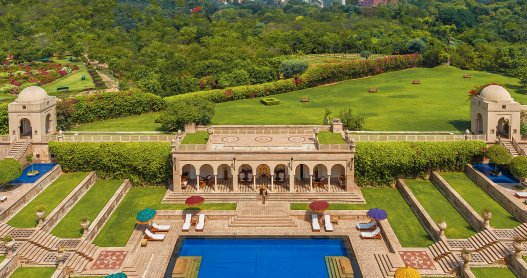Overview
When’s the best time to go to New Delhi?
Delhi is best experienced between October and March: a time of moderate temperatures, little rain, and festivals galore. April through September can be hot and muggy, and the seasonal summer rains only complicate matters. Heavy fog in December and January can affect flight and train schedules, as well as early morning sight-seeing—so plan ahead.
How to get around New Delhi
The city center is approximately 45 minutes from the airport, and you can reserve a taxi or private vehicle after exiting baggage claim. The metro—which offers air conditioning and female-only compartments—is an affordable, reliable, and environmentally friendly option, but can also be congested with heavy crowds. Taxis are required by law to register as commercial vehicles, and they do have meters, although many drivers prefer to set a pre-paid flat rate. Surcharges will be applied for extra baggage, night rides, and tolls. Buses, usually run by the government, provide a cheap and convenient mode of public transportation. New features like air conditioning and low-floor lifts are being installed on city buses to improve the system and to draw private car owners away from busy roads. An auto-rickshaw, or tuk-tuk, is a three-wheeled motor vehicle for hire. Generally green, yellow, or black in color, auto-rickshaws have regulated, metered fares, and are common throughout the city. Private vehicles also povide a cheap, flexible, and comfortable option, but be sure to check that the car is licensed for tourists.
Can’t miss things to do in New Delhi
Old Delhi is a culinary, architectural, and historical adventure. Start at the Red Fort, a sandstone fortress that covers nearly 255 acres. Consider returning in the evening when the fort comes alive with a sound-and-light show that recreates 5,000 years of India’s history. Next, continue to Jama Masjid, the largest mosque in India, which was commissioned by Shah Jahan—the same emperor who built the iconic Taj Mahal. Step outside the gates and enter Chandni Chowk, which is touted as the oldest and busiest street market in Delhi. Chandni Chowk hosts an impressive mix of shops that specialize in goods such as silk, silver, crafts, spices, and leather products. Find renowned restaurants, food stands, and sweet shops—including the original Haldiram’s, Meghraj and Sons, Bikaner Sweet Shop, and Ghantewala Halwai. The street also houses several different religious shrines that illustrate a genuine cultural harmony: Sri Digambar Jain Lal Mandir and Bird Sanctuary, Gauri Shankar Hindu Temple, Sikh Gurdwara Sis Ganj Sahib, and Central Baptist Church. You’ll also find historic private residences nestled amid a labyrinth of small streets and neighborhoods around Chandni Chowk.
Food and drink to try in New Delhi
Delhi has a vibrant food scene including award-winning restaurants, roadside stands, and comfort food—lots of comfort food. Restaurants typically fall into two categories: veg (vegetarian) and non-veg. Remember that the cow is sacred in India, so beef is difficult to find. In the neighboring city of Gurgaon, permits are now issued for legal microbreweries, and creative new pubs are gaining popularity. India has also won numerous international accolades for beer, wine, and rum.
Culture in New Delhi
Delhi is such a multicultural society that each religious and ethnic demographic celebrates its own festivals. Diwali, the Festival of Lights, is celebrated in October/November with a profusion of lamps, fireworks, and anything that sparkles. Holi, the Festival of Colors, is a Hindu celebration at the end of the winter season. Bonfires are lit to signify a devotion to Lord Vishnu, the God of Preservation, and people gather to throw colored powder and water at each other. Many children make a game out of throwing powder on foreigners—even hiding in trees to sprinkle handfuls of red, green, blue, and gold powder on the heads of unsuspecting tourists.
Delhi is also home to an excellent collection of museums and cultural relics. The National Handicrafts and Handloom Museum displays tribal and rural art and artifacts. With over 35,000 pieces ranging from textiles to clay, the space is a welcoming community of artisans and art lovers. Each month, approximately 50 craftspeople from across the country are invited to reside on the property and demonstrate their talents. Don’t miss the Village Complex, an exhibition that displays village life from varying regions in India. Akshardham, located across the Yamuna River in Noida, is an elaborate Swaminarayan temple complex that features an IMAX theater, musical fountains, sunken gardens, and the Mandir: a temple with over 20,000 statues of India’s religious personalities. Be sure to experience the 12-minute boat ride that highlights over 10,000 years of India’s heritage, including inventions, discoveries, and the world’s first university, Takshashila.
Local travel tips for New Delhi
Distances are misleading in Delhi, so aim to group your activities by routes and time of day. A restaurant may only be a couple of miles away—but depending on traffic, the drive can take an hour or longer! The metro is a reliable and affordable way to reach neighboring cities like Gurgaon or Noida.







